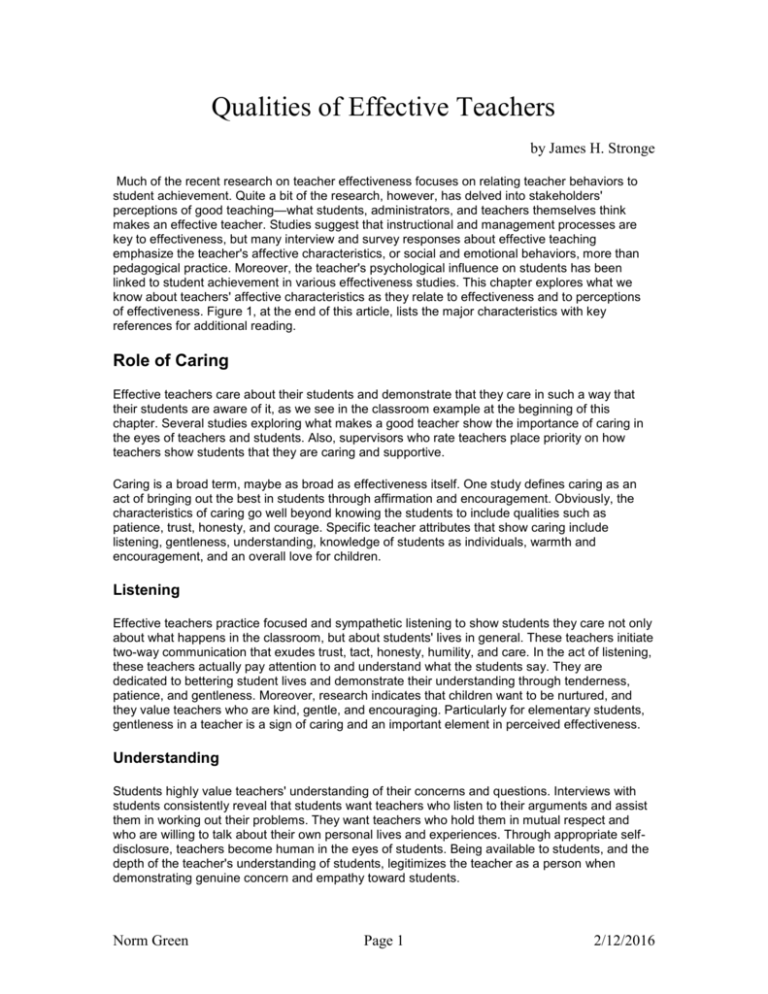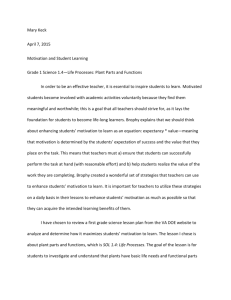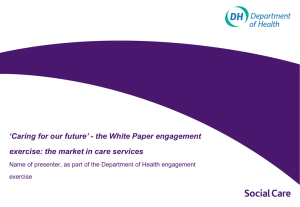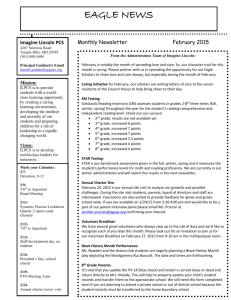
Qualities of Effective Teachers
by James H. Stronge
Much of the recent research on teacher effectiveness focuses on relating teacher behaviors to
student achievement. Quite a bit of the research, however, has delved into stakeholders'
perceptions of good teaching—what students, administrators, and teachers themselves think
makes an effective teacher. Studies suggest that instructional and management processes are
key to effectiveness, but many interview and survey responses about effective teaching
emphasize the teacher's affective characteristics, or social and emotional behaviors, more than
pedagogical practice. Moreover, the teacher's psychological influence on students has been
linked to student achievement in various effectiveness studies. This chapter explores what we
know about teachers' affective characteristics as they relate to effectiveness and to perceptions
of effectiveness. Figure 1, at the end of this article, lists the major characteristics with key
references for additional reading.
Role of Caring
Effective teachers care about their students and demonstrate that they care in such a way that
their students are aware of it, as we see in the classroom example at the beginning of this
chapter. Several studies exploring what makes a good teacher show the importance of caring in
the eyes of teachers and students. Also, supervisors who rate teachers place priority on how
teachers show students that they are caring and supportive.
Caring is a broad term, maybe as broad as effectiveness itself. One study defines caring as an
act of bringing out the best in students through affirmation and encouragement. Obviously, the
characteristics of caring go well beyond knowing the students to include qualities such as
patience, trust, honesty, and courage. Specific teacher attributes that show caring include
listening, gentleness, understanding, knowledge of students as individuals, warmth and
encouragement, and an overall love for children.
Listening
Effective teachers practice focused and sympathetic listening to show students they care not only
about what happens in the classroom, but about students' lives in general. These teachers initiate
two-way communication that exudes trust, tact, honesty, humility, and care. In the act of listening,
these teachers actually pay attention to and understand what the students say. They are
dedicated to bettering student lives and demonstrate their understanding through tenderness,
patience, and gentleness. Moreover, research indicates that children want to be nurtured, and
they value teachers who are kind, gentle, and encouraging. Particularly for elementary students,
gentleness in a teacher is a sign of caring and an important element in perceived effectiveness.
Understanding
Students highly value teachers' understanding of their concerns and questions. Interviews with
students consistently reveal that students want teachers who listen to their arguments and assist
them in working out their problems. They want teachers who hold them in mutual respect and
who are willing to talk about their own personal lives and experiences. Through appropriate selfdisclosure, teachers become human in the eyes of students. Being available to students, and the
depth of the teacher's understanding of students, legitimizes the teacher as a person when
demonstrating genuine concern and empathy toward students.
Norm Green
Page 1
2/12/2016
Knowing Students
Effective, caring teachers know students both formally and informally. They use every opportunity
at school and in the community to keep the lines of communication open. Many educational
stakeholders emphasize that effective teachers know their students individually, not only
understanding each student's learning style and needs, but also understanding the student's
personality, likes and dislikes, and personal situations that may affect behavior and performance
in school. Effective teachers care for the student first as a person, and second as a student. They
respect each student as an individual.
Research on caring teachers yields the following important points:
Caring teachers who know their students create relationships that enhance the learning
process.
Effective teachers consistently emphasize their love for children as one key element of
their success.
Teachers who create a supportive and warm classroom climate tend to be more effective
with all students.
Caring teachers are intentionally aware of student cultures outside the school.
Caring teachers truly believe that each student has a right to a caring and competent
teacher.
Caring teachers appropriately respect confidentiality issues when dealing with students.
Caring teachers regard the ethic of care and learning as important in educating students
to their full potential.
Key references:
Bain & Jacobs, 1990; Brophy & Good, 1986; Collinson, Killeavy, & Stephenson, 1999; Cotton,
1999; Cotton, 2000; Cruickshank & Haefele, 2001; Emmer, Evertson, & Anderson, 1980; Good &
Brophy, 1997; Johnson, 1997; National Association of Secondary School Principals, 1997; Peart
& Campbell, 1999; Thomas & Montomery, 1998; Wang, Haertel, & Walberg, 1993a; Wang,
Haertel, & Walberg, 1993b; Yamaguchi, Strawser, & Higgins, 1997
Role of Fairness and Respect
Beyond a demonstration of caring, an effective teacher establishes rapport and credibility with
students by emphasizing, modeling, and practicing fairness and respect. Respect and equity are
identified as the prerequisites of effective teaching in the eyes of students. In fact, students
interviewed for their views on effective teachers consistently note the importance of fairness and
respect at all levels of schooling—from elementary through high school.
The elements of fairness and respect are highlighted in many studies. Students stated that
effective teachers respond to misbehavior at an individual level rather than holding a whole class
responsible for the actions of one student or a small group of students. They know and
understand the facts before responding to any disciplinary situation, and then tell students
specifically what they did wrong. Moreover, they tell students what they need to do right.
Furthermore, students expect teachers to treat them equitably—when they behave as well as
misbehave—and to avoid demonstrations of favoritism.
Effective teachers continually demonstrate respect and understanding, along with fairness
regarding race, cultural background, and gender. Students' perceptions of teacher effectiveness
emphasize racial impartiality with equitable treatment of all students. The students expect
teachers not to allow ethnicity to affect their treatment or expectations of students.
Norm Green
Page 2
2/12/2016
Interviews and surveys of perceptions of fairness in the classroom indicate the following key
points:
Students associate respect with fairness and expect teachers to treat them as people.
Students perceive effective teachers as those who avoid using ridicule and who prevent
situations in which students lose respect in front of their peers.
Effective teachers practice gender, racial, and ethnic fairness.
Students associate fairness and respect with a teacher being consistent and providing
opportunities for students to have input into the classroom.
Effective teachers offer all students opportunities to participate and to succeed.
Key references:
Collinson, Killeavy, & Stephenson, 1999; Cotton, 1999; Cotton, 2000; Emmer, Evertson, &
Anderson, 1980; Good & Brophy, 1997; McBer, 2000; National Association of Secondary School
Principals, 1997; Peart & Campbell, 1999; Thomas & Montomery, 1998; Yamaguchi, Strawser, &
Higgins, 1997
Social Interactions with Students
Teachers and students spend much of their day interacting academically. However, social
interactions and those that give the teacher opportunities to demonstrate caring, fairness, and
respect have been shown to be an important element of teacher effectiveness. A teacher's ability
to relate to students and to make positive, caring connections with them plays a significant role in
cultivating a positive learning environment and promoting student achievement.
Effective teachers use a wide variety of strategies to interact with students. However, the basis
for these interactions goes beyond the four walls of the classroom. In fact, students revealed that
effective teachers demonstrate interest in students' lives beyond the classroom. Teachers who
attend sporting events, concerts, and other special programs in which their students participate
are valued by their students. Additionally, researchers contend that constructive social
interactions between teachers and students not only contribute to student learning and
achievement, but also increase student self-esteem by fostering feelings of belonging to the
classroom and the school.
Teachers who are aware of their own style of interacting with their students are able to provide a
more favorable learning environment for all students. Through social interactions with students,
effective teachers are able to individually, realistically, and successfully challenge each and every
student to succeed.
Aspects of effective teaching related to social interaction involve the following:
Effective teachers consistently behave in a friendly and personal manner while
maintaining appropriate teacher-student role structure.
Effective teachers work with students as opposed to doing things to or for them.
Productive interactions involve giving students responsibility and respect; also treating
secondary students as adults when appropriate.
Teachers who are considered effective allow students to participate in decision making.
Effective teachers pay attention to what students have to say.
Students indicate that effective teachers spend more time interacting and working directly
with them than ineffective teachers.
Norm Green
Page 3
2/12/2016
When interacting with students, effective teachers demonstrate a sense of fun and a
willingness to play or participate.
Effective teachers have a good sense of humor and are willing to share jokes.
Key references:
Bain & Jacobs, 1990; Bloom, 1984; Brookhart & Loadman, 1992; Collinson, Killeavy, &
Stephenson, 1999; Cotton, 1999; Cotton, 2000; Cruickshank & Haefele, 2001; Darling-Hammond,
2001; Education USA Special Report, no date; Good & Brophy, 1997; Johnson, 1997; Kohn,
1996; National Association of Secondary School Principals, 1997; Peart & Campbell, 1999; Porter
& Brophy, 1988; Thomas & Montomery, 1998; Wang, Haertel, & Walberg, 1993a; Wang, Haertel,
& Walberg, 1993b; Yamaguchi, Strawser, & Higgins, 1997
Promotion of Enthusiasm and Motivation for Learning
The teacher's enthusiasm for teaching, learning, and for the subject matter has been shown to be
an important part of effective teaching, both in supporting positive relationships with students and
in encouraging student achievement. Based on student interviews, teachers can effectively
motivate most students by encouraging them to be responsible for their own learning, maintaining
an organized classroom environment, setting high standards, assigning appropriate challenges,
and providing reinforcement and encouragement during tasks. These students see effective
teachers as motivational leaders.
Research indicates that effective teachers have residual positive effects on their students'
willingness to work to their potential and beyond. Consequently, less effective teachers may
actually extinguish students' interest in the subject. Good teachers realize and deal with the fact
that some students prefer to sit quietly on the sideline; however, they do not stop involving them.
By finding a way to motivate a student to learn, a teacher contributes to a student's evolving
attitude toward a particular subject or activity. In other words, the teacher can bring out the best in
that student. An effective teacher recognizes that students vary in their motivation levels. An
effective teacher knows how to support intrinsically motivated students and seeks ways to provide
extrinsic motivation to students who need it. Motivating students consists of making students
receptive to and excited about learning, as well as making them aware of the importance and
value of learning itself. By establishing positive attitudes and perceptions about learning, the
effective teacher makes the learner feel comfortable in the classroom. As a particular example of
establishing positive attitudes, teachers who provide mastery learning techniques for their
students improve the attitudes of their students. They also increase academic self-concept,
interest in the subject area, and the desire to learn more about the subject. Emphasizing higher
mental processes along with mastery learning strategies tends to create a learning environment
that is exciting and constantly new and playful.
Researchers have investigated the influence of teacher enthusiasm on student motivation and
learning, with the following results and conclusions:
High levels of motivation in teachers relate to high levels of achievement in students.
Teachers' enthusiasm for learning and for the subject matter under study has been
shown to be an important factor in student motivation, which is closely linked to student
achievement.
A teacher's involvement in graduate studies, which indicates enthusiasm for learning,
may be a source of motivation and may translate into higher achievement among
students.
Norm Green
Page 4
2/12/2016
Some studies indicate that the enthusiasm factor is more significant with older students
than younger ones, but effective primary teachers also have demonstrated enthusiasm
for their work as part of their overall effectiveness.
Key references:
Bain & Jacobs, 1990; Bloom, 1984; Brophy & Good, 1986; Collinson, Killeavy, & Stephenson,
1999; Covino & Iwanicki, 1996; Darling-Hammond, 2000; Johnson, 1997; Marzano, Pickering, &
McTighe, 1993; Monk & King, 1994; Palmer, 1990; Peart & Campbell, 1999; Rowan, Chiang, &
Miller, 1997; Wang, Haertel, & Walberg, 1993a; Wang, Haertel, & Walberg, 1993b
Attitude Toward the Teaching Profession
An important facet of professionalism and of effectiveness in the classroom is a teacher's
dedication to students and to the job of teaching. Through examination of several sources of
evidence, a dual commitment to student learning and to personal learning has been found
repeatedly in effective teachers. A common belief among effective teachers, which reveals their
dual commitment, is that it is up to them to provide a multitude of tactics to reach students. In
essence, effective teachers view themselves as responsible for the success of their students.
The effective teacher truly believes that all students can learn—it is not just a slogan. These
teachers also believe that they must know their students, their subject, and themselves, while
continuing to account for the fact that students learn differently. Through differentiation of
instruction, effective teachers reach their students and together they enjoy their successes.
Effective teachers also work collaboratively with other staff members. They are willing to share
their ideas and assist other teachers with difficulties. Collaborative environments create positive
working relationships and help retain teachers. Additionally, effective teachers volunteer to lead
work teams and to be mentors to new teachers. Effective teachers are informal leaders on the
cutting edge of reform and are not afraid to take risks to improve education for all students. These
informal leaders are the ones administrators typically call on for opinions and help in effecting
change.
Effective teachers invest in their own education. They model to their students that education and
learning are valuable by taking classes and participating in professional development,
conferences, and inservice training. Additionally, they discuss their participation in these activities
with students in a positive manner. Effective teachers learn and grow as they expect their
students to learn and grow. They serve as powerful examples of lifelong learners as they find
ways to develop professionally.
The relationship between teachers' attitudes and effectiveness can be summarized:
Effective teachers exude positive attitudes about life and teaching.
Extra hours spent preparing and reflecting upon instruction are well worth the student
outcomes—specifically achievement.
Promoting and participating in a collegial, collaborative work environment results in more
positive attitudes in teachers.
Effective teachers do not make excuses for student outcomes; they hold their students
responsible while also accepting responsibility themselves.
Norm Green
Page 5
2/12/2016
Key references:
Bain & Jacobs, 1990; Blair, 2000; Brookhart & Loadman, 1992; Cawelti, 1999b; Covino &
Iwanicki, 1996; McBer, 2000; Mitchell, 1998; National Board for Professional Teaching Standards,
no date; Porter & Brophy, 1988; Rowan, Chiang, & Miller, 1997; Thomas & Montomery, 1998;
Virshup, 1997; Wong & Wong, 1998
Role of Reflective Practice
Another element of professionalism often cited as part of effective teaching is a teacher's
reflective practice, or careful review of and thoughtfulness about one's own teaching process. The
role of reflection has been described repeatedly in studies of teacher effectiveness. Those studies
include interviews and surveys of teachers judged effective according to their students'
achievement rates, studies of teachers certified under the National Board of Professional
Teaching Standards, and case studies of effective schools. Effective teachers continuously
practice self-evaluation and self-critique as learning tools. Reflective teachers portray themselves
as students of learning. They are curious about the art and science of teaching and about
themselves as effective teachers. They constantly improve lessons, think about how to reach
particular children, and seek and try out new approaches in the classroom to better meet the
needs of their learners.
Some researchers define reflective teachers as introspective. They seek a greater understanding
of teaching through scholarly study and professional reading. Through reflective practice,
effective teachers monitor their teaching because they want to be better teachers and to make a
difference in the lives of students.
Effective teachers are not afraid of feedback; in fact, they elicit information and criticism from
others. Additionally, in the interest of improving their ability to have a positive impact on student
learning, these teachers readily accept constructive criticism and reflect upon it. Reflective
practice can initially result in confusion for the teacher; the process requires open-mindedness,
honesty, and sufficient time to change teaching behaviors.
Thoughtful questions generated by research can guide teachers in reflecting on practice.
Effective teachers realize that reflective practices are more than simply preservice or inservice
exercises. Indeed, reflective practices are crucial to lifelong learning and a professional necessity.
Thoughtful reflection translates into enhanced teacher efficacy. And a teacher's sense of efficacy
has an impact on how she approaches instructional content and students. While efficacy does
change for teachers as they encounter new experiences, such as materials and grade levels,
they are more likely to have additional positive experiences as they reflect on these new
experiences. Educators' confidence in their ability to facilitate the learning and understanding of
material by students is observable by others. In particular, when teachers are confident, they
communicate the belief of their own efficacy to students.
Additional findings on the value of reflective practices include the following:
Effective teachers may reflect on their work formally or informally; for example, they may
review a day's work mentally, keep a journal or portfolio, meet regularly with a mentor or
with colleagues, or assess a videotaped recording of their teaching. Regardless of the
mode, the key is reflection.
Teachers whose students have high achievement rates continually mention reflection on
their work as an important part of improving their teaching.
Norm Green
Page 6
2/12/2016
Belief in one's efficacy and maintaining high expectations for students are common
among teachers who reflect.
Key references:
Collinson, Killeavy, & Stephenson, 1999; Covino & Iwanicki, 1996; Cruickshank & Haefele, 2001;
Demmon-Berger, 1986; Good & Brophy, 1997; Mitchell, 1998; National Board for Professional
Teaching Standards, no date; Thomas & Montomery, 1998
Figure 2.1. Key References: The Teacher as a Person
Reference
Bain &
Jacobs,
1990
Fairness Interactions Enthusiasm Attitude
Reflective
Caring &
with
&
Toward
Practice
Respect Students
Motivation Teaching
X
X
X
Blair, 2000
X
Bloom,
1984
X
Brookhart
& Loadman,
1992
X
Brophy &
Good, 1986
X
X
X
X
Cawelti,
1999b
X
Collinson,
Killeavy, &
Stephenson,
1999
X
X
X
Cotton,
1999
X
X
X
Cotton,
2000
X
X
X
Covino &
Iwanicki,
1996
Cruickshank
& Haefele,
2001
X
X
X
X
DarlingHammond,
Norm Green
X
X
X
X
X
X
Page 7
2/12/2016
2000
DarlingHammond,
2001
X
DemmonBerger,
1986
X
Education
USA
Special
Report, no
date
X
Emmer,
Evertson, &
Anderson,
1980
X
X
Good &
Brophy,
1997
X
X
Johnson,
1997
X
X
X
Kohn, 1996
X
X
X
Marzano,
Pickering,
& McTighe,
1993
X
McBer,
2000
X
X
Mitchell,
1998
Monk &
King, 1994
National
Association
of
Secondary
School
Principals,
1997
X
X
X
X
X
X
X
National
Board for
Professional
Teaching
Standards,
no date
Norm Green
X
Page 8
2/12/2016
Palmer,
1990
Peart &
Campbell,
1999
X
X
X
Porter &
Brophy,
1988
X
X
Rowan,
Chiang, &
Miller, 1997
Thomas &
Montomery,
1998
X
X
X
X
X
X
X
Virshup,
1997
Wang,
Haertel, &
Walberg,
1993a,
1993b
X
X
X
X
Wong &
Wong, 1998
Yamaguchi,
Strawser, &
Higgins,
1997
X
X
X
X
X
X
Copyright © 2002 by the Association for Supervision and Curriculum Development (ASCD). All rights reserved. No part of this
publication may be reproduced or transmitted in any form or by any means, electronic or mechanical, including photocopy,
recording, or any information storage and retrieval system, without permission from ASCD.
Norm Green
Page 9
2/12/2016









